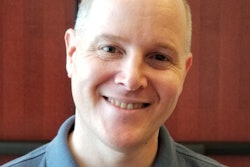
Efforts to apply artificial intelligence (AI) technology to medical imaging are advancing at a dizzying pace. There will be no better place to witness this growth than the second Society for Imaging Informatics in Medicine (SIIM) Conference on Machine Intelligence in Medical Imaging (C-MIMI) next week in Baltimore.
The first C-MIMI was held in September 2016 in Alexandria, VA, and this year's edition will take place September 26-27 at the Turner Building/Auditorium on the campus of Johns Hopkins Medicine. C-MIMI 2017 will feature keynote talks, more than 30 scientific paper and poster presentations, a vendor perspective session, and hands-on training labs, according to SIIM.
 Dr. Bradley Erickson, PhD, from the Mayo Clinic.
Dr. Bradley Erickson, PhD, from the Mayo Clinic.Hot topics at the meeting will include access to the data needed to train the algorithms, as well as U.S. Food and Drug Administration (FDA) approval of the software, according to conference co-chair Dr. Bradley Erickson, PhD, of the Mayo Clinic in Rochester, MN.
"I was mostly impressed with the wide range of applications and approaches, which means to me that we are still early on the technology curve," Erickson said.
"I think new deep-learning technology will also be topics of great interest," he told AuntMinnie.com.
SIIM Chair Paul Nagy, PhD, of Johns Hopkins University and Dr. Eliot Siegel of the University of Maryland are the other two co-chairs for C-MIMI.
Notably, the second day of the meeting will primarily be a deep-learning training session held in collaboration with graphics processing unit (GPU) developer NVIDIA. The NVIDIA Deep Learning Institute will give attendees the opportunity to receive hands-on training in developing deep-learning algorithms.
Other highlights are described below.
Day 1
Following a welcome and opening remarks by the three C-MIMI co-chairs, Michael Jacobs, PhD, of Johns Hopkins will discuss how advanced computational radiology represents a new frontier for radiomics, machine learning, and deep learning. In a late addition to the program, Dr. Gregory Moore, PhD, vice president of healthcare at Google Cloud, will give a keynote talk called "Intelligent Medical Imaging at Scale: Insights From Applying Deep Learning."
Moore's talk will be followed by the first of three scientific paper sessions at C-MIMI. Six papers will be presented in each of the sessions. After a short midmorning break, the second paper session will complete the morning program.
C-MIMI will resume after lunch with a presentation by the SIIM Machine Learning Committee, followed by the third and final paper session. Following a midafternoon break, seven vendor representatives will discuss a variety of AI topics in a vendor perspective session. The day will then conclude with a reception and presentations of 13 posters.
Day 2
Day 2 will kick off with a keynote talk by Berkman Sahiner, PhD, leader of the FDA's Division of Imaging, Diagnostics, and Software Reliability (DIDSR) Image Analysis Laboratory. Sahiner will share the FDA's perspectives on machine learning and software development for medical image interpretation.
The remainder of the day will feature an NVIDIA Deep Learning Institute (DLI) session, and attendees should bring their own laptops. The first of three DLI labs will demonstrate how to leverage convolutional neural networks to solve a real-world image classification problem using NVIDIA's Deep Learning GPU Training System (DIGITS), according to SIIM.
In this training session, attendees will receive computer code that solves example medical imaging problems as IPython notebooks -- an interactive computational environment.
"There are intentional bugs or gaps to make sure people understand the examples," Erickson said.
After a short midmorning break, the second DLI lab will teach attendees how to train and evaluate an image segmentation network using the TensorFlow open-source software library for machine learning. After lunch, the final session of C-MIMI 2017 will help participants learn to set up their own image segmentation workflow in DIGITS and adapt it to a medical use case, according to SIIM.




















